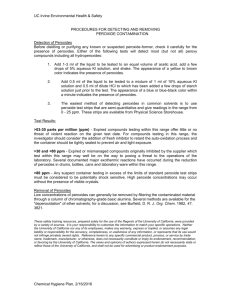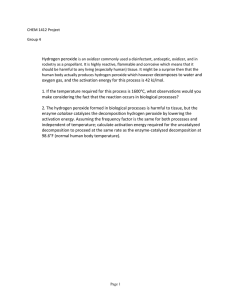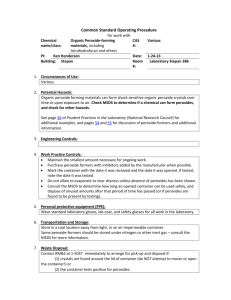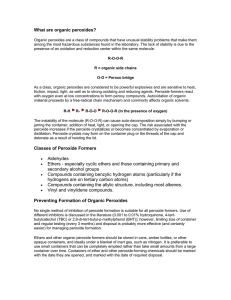Arkema Inc. - Organic Peroxides Storage Temperature, SADT, and
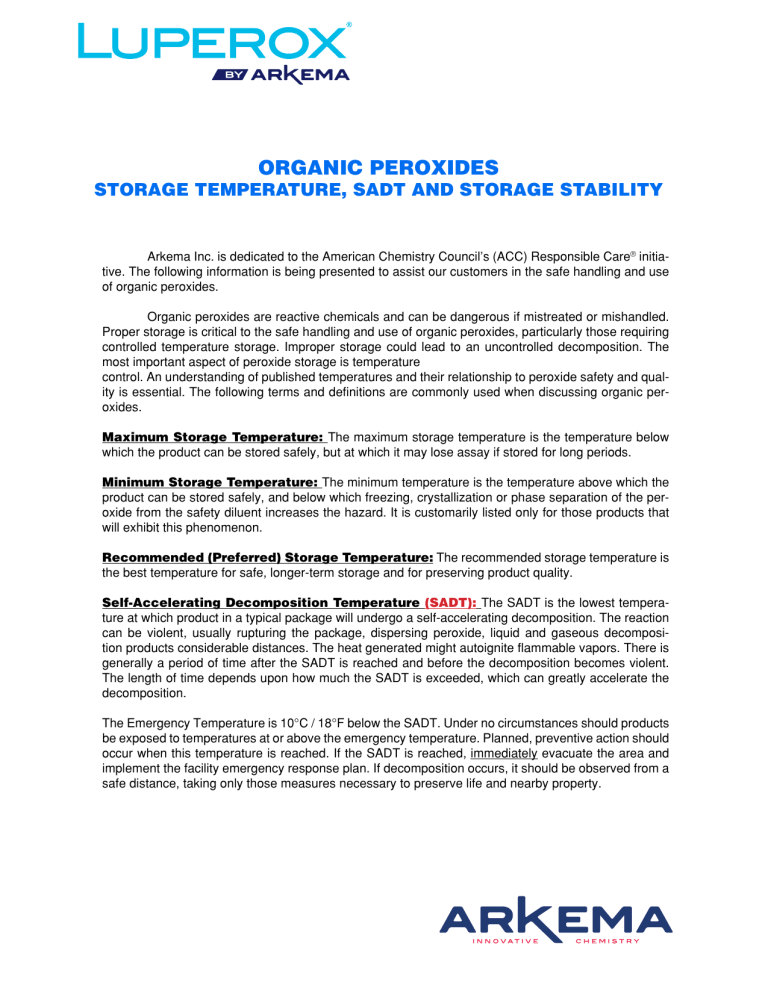
ORGANIC PEROXIDES
STORAGE TEMPERATURE, SADT AND STORAGE STABILITY
Arkema Inc. is dedicated to the American Chemistry Council’s (ACC) Responsible Care ® initiative. The following information is being presented to assist our customers in the safe handling and use of organic peroxides.
Organic peroxides are reactive chemicals and can be dangerous if mistreated or mishandled.
Proper storage is critical to the safe handling and use of organic peroxides, particularly those requiring controlled temperature storage. Improper storage could lead to an uncontrolled decomposition. The most important aspect of peroxide storage is temperature control. An understanding of published temperatures and their relationship to peroxide safety and quality is essential. The following terms and definitions are commonly used when discussing organic peroxides.
Maximum Storage Temperature: The maximum storage temperature is the temperature below which the product can be stored safely, but at which it may lose assay if stored for long periods.
Minimum Storage Temperature: The minimum temperature is the temperature above which the product can be stored safely, and below which freezing, crystallization or phase separation of the peroxide from the safety diluent increases the hazard. It is customarily listed only for those products that will exhibit this phenomenon.
Recommended (Preferred) Storage Temperature: The recommended storage temperature is the best temperature for safe, longer-term storage and for preserving product quality.
Self-Accelerating Decomposition Temperature (SADT): The SADT is the lowest temperature at which product in a typical package will undergo a self-accelerating decomposition. The reaction can be violent, usually rupturing the package, dispersing peroxide, liquid and gaseous decomposition products considerable distances. The heat generated might autoignite flammable vapors. There is generally a period of time after the SADT is reached and before the decomposition becomes violent.
The length of time depends upon how much the SADT is exceeded, which can greatly accelerate the decomposition.
The Emergency Temperature is 10°C / 18°F below the SADT. Under no circumstances should products be exposed to temperatures at or above the emergency temperature. Planned, preventive action should occur when this temperature is reached. If the SADT is reached, immediately evacuate the area and implement the facility emergency response plan. If decomposition occurs, it should be observed from a safe distance, taking only those measures necessary to preserve life and nearby property.
Typically, the SADT is inversely proportional to package size. Larger packages will have a lower SADT due to a smaller surface-to-volume ratio that limits the dissipation of heat. Consult the product label and Material
Safety Data Sheet (MSDS) for product specific SADT data.
Transportation Control Temperature: Per 49CFR173.21, the transportation control temperature is the temperature above which a package of the material may not be offered for transportation. In general terms for all refrigerated products, this temperature is the maximum recommended temperature for transport and is listed in the DOT organic peroxide transportation table (49CFR173.225) and appears on the shipper’s bill of lading (BOL).
Transportation Emergency Temperature: Per 49CFR173.21, the transportation emergency temperature is the temperature at which, due to imminent danger, emergency measures must be initiated. For all temperature controlled products, this temperature is set by the DOT to be 10°C below the SADT and is listed in the DOT organic peroxide transportation table (49CFR173.225) and appears on the shipper’s bill of lading (BOL).
Organic Peroxide Shelf Life: The shelf life is the time period during which a peroxide must be used in order to realize desired, optimum activity in end-use applications. Organic peroxides are inherently unstable chemicals and therefore have a limited shelf-life, primarily depending upon the temperatures to which they are exposed. For Arkema Inc. organic peroxides, the shelf-life period begins when the peroxide is delivered to the customer and is primarily dependent upon storage temperature. See the “ Storage Stability ” section for additional information.
AMBIENT TRANSPORT & STORAGE
In accordance with US DOT 49CFR 173.21 and the UN Recommendations on the Transport of
Dangerous Goods-Model Regulations (2.5.3.4.1), organic peroxide formulations with a SADT of >50°C
/122°F do not require controlled temperature transport.
Ambient transport organic peroxides can be stored safely at or below a MAXIMUM storage temperature of 38°C / 100°F , however the RECOMMENDED storage temperature is below 30°C / 86°F to maintain product quality. Detached storage is preferred in a cool, wellventilated place out of direct sunlight. Organic peroxides must be stored away from combustibles and incompatible materials. Refer also to the National
Fire Protection Association (NFPA) Code 432, Code for the Storage of Organic Peroxide Formulations for additional information.
• ALWAYS: Refer to the Product Label or Material Safety Data Sheet (MSDS sections 7
and 9) for product specific Storage Temperature requirements and SADT.
• ALWAYS: Maintain product below the MAXIMUM Storage Temperature.
• ALWAYS: Have a facility safety protocol in place if the storage temperature reaches the
emergency temperature, 10°C / 18°F below the SADT.
• ALWAYS: Practice First-In-First-Out (FIFO) Inventory Management.
TEMPERATURE CONTROLLED TRANSPORT & STORAGE
In accordance with US DOT 49CFR 173.21 and the UN Recommendations on the Transport of
Dangerous Goods-Model Regulations (2.5.3.4.1), organic peroxide formulations with a SADT of < 50°C
/122°F require controlled temperature transport.
Transportation Emergency and Control Temperatures are derived from the SADT and are listed in the transport regulations for each specific product. Refer to the MSDS (section 14), shipper’s
Bill of Lading or 49CFR173.225 for the required temperatures.
The product-specific storage temperature for temperature controlled formulations is always AT or BELOW the transportation control temperature (refer to MSDS or Product Label).
At customer facilities, back-up or emergency refrigeration should be available in case primary refrigeration is lost. Emergency dry ice source(s) should be known in case of refrigeration failure. Temperature in storage areas should be monitored. Refrigeration systems should have at least a high temperature alarm to warn of loss of refrigeration, and preferably a secondary alarm set for the lowest Emergency Temperature of any peroxide in storage.
• ALWAYS: Refer to the Product Label or Material Safety Data Sheet (MSDS section 7
and 9) for product specific Storage Temperature and SADT.
• ALWAYS: Maintain product at or below the RECOMMENDED Storage Temperature.
• ALWAYS: Minimize exposure to ambient temperatures and prevent unnecessary
exposure to sunlight.
• UPON RECEIPT: Promptly place product in a temperature controlled storage area.
• ALWAYS: Practice First-In-First-Out (FIFO) Inventory Management.
STORAGE STABILITY AND SHELF LIFE
(by Organic Peroxide Family)
When stored at or below the recommended storage temperatures in their original containers, organic peroxides will maintain activity in end-use applications for a minimum of three months after the date of delivery. Storage at temperatures higher than the published recommended temperatures and below the
SADTs adversely affects product quality. The extent of assay change depends upon the temperature(s) and length of exposure. Product that has been exposed to temperatures greater than the recommended temperature for long periods of time should be analyzed to determine the assay and suitability for use. (Minor assay loss might mean simply making weight adjustments necessary for successful application, major loss might mean disposal instead of use.)
First-In-First-Out (FIFO) inventory management is essential due to the unique characteristics of organic peroxides. Customers should have a system to carefully control their inventories and use older product first to assure desired peroxide activity in end-use applications. A procedure for out-of-date product should be developed. The following shelf-life guidelines are provided to aid in inventory control.
ORGANIC PEROXIDE
FAMILY
DIPEROXYKETALS
SHELF-LIFE*
(# of months after delivery)
6 Months
PEROXYDICARBONATES
PEROXYESTERS
DIACYL PREOXIDES
(except benzoyl peroxide & benzoyl peroxide pastes)
· Benzoyl Peroxide
· Benzoyl Peroxide Pastes
KETONE PEROXIDES
DIALKYL PEROXIDES 12 Months
HYDROPEROXIDES
* Shelf-life when stored at or below recommended storage temperature.
3 Months
6 Months
6 Months
12 Months
6 Months (35-85°F) or 3 Months (86-100°F)
6 Months (65-85°F) or 3 Months (86-100°F)
12 Months
6 Months
IN CASE OF EMERGENCY CALL CHEMTREC
1- 800 - 424 - 9300
(24 hours / day)
Arkema Inc. • Organic Peroxides • www.luperox.com
2000 Market Street, Philadelphia, Pa. 19103
Phones: (800) 558-5575 • Fax: (215) 419-7413
© 2007 Arkema Inc. All rights reserved.
Responsible Care ® is a registered trademark of the American Chemistry Council.
IMPORTANT: The statements, technical information and recommendations contained herein are believed to be accurate as of the date hereof. Since the conditions and methods of use of the product and of the information referred to herein are beyond our control, Arkema expressly disclaims any and all liability as to any results obtained or arising from any use of the product or reliance on such information; NO WARRANTY OF FITNESS FOR ANY PARTICULAR
PURPOSE, WARRANTY OF MERCHANTABILITY, OR ANY OTHER WARRANTY, EXPRESS OR IMPLIED, IS MADE
CONCERNING THE GOODS DESCRIBED OR THE INFORMATION PROVIDED HEREIN. The information provided herein relates only to the specific product designated and may not be applicable when such product is used in combination with other materials or in any process. The user should thoroughly test any application before commercialization. Nothing contained herein should be taken as an inducement to infringe any patent and the user is advised to take appropriate steps to be assured that any proposed use of the product will not result in patent infringement.



